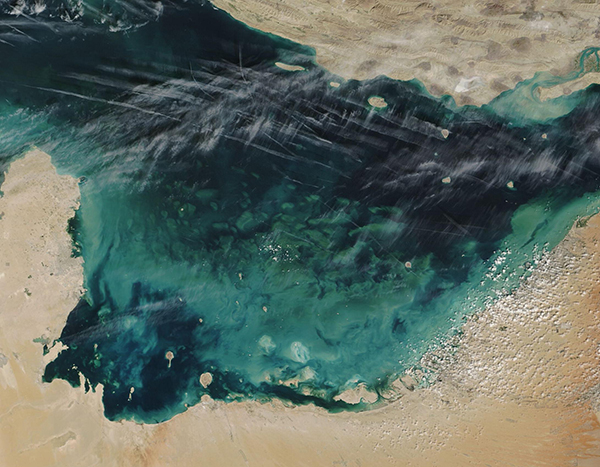Images
February 12, 2023 - Blooms, Sediment, and Contrails over the Persian Gulf
Tweet
On February 10, 2023, the Moderate Resolution Imaging Spectroradiometer (MODIS) on board NASA’s Terra satellite acquired a true-color image of a very colorful Persian Gulf. The image is centered on the southern Persian Gulf, which is flanked by Qatar, Saudi Arabia, and the United Arab Emirates on the south and Iran in the north. Part of the Strait of Hormuz and Qeshm Island can be seen in the upper right.
Jewel-toned greens and tans color the waters of the Persian Gulf, especially near the coast of the Arabian Peninsula. These tints are likely primarily caused by sediment, possibly deposited by run-off from land or from a recent heavy dust storm. When floating close to the surface, sediment appears tan but as it sinks, it appears green and then blue as it dissipates. It’s also likely that blooms of phytoplankton contribute to the colorful waters. These microscopic plant-like organisms live in these waters year-round and, when conditions are favorable, can reproduce explosively to cause large floating colonies that appear green or blue from space.
White streaks across the sky are condensation trails (contrails) and mark the passage of aircraft. Contrails are a type of cirrus cloud that forms in nearly the same way as naturally occurring cirrus. The difference lies in the source of ingredients. Aircraft exhaust contains an abundance of water vapor and small particles. At high altitudes, where it’s cold enough—at least -39°C (-38°F)—the water vapor can easily freeze onto the particles and form these long, narrow clouds.
Image Facts
Satellite:
Terra
Date Acquired: 2/10/2023
Resolutions:
1km (103.4 KB), 500m (282.7 KB), 250m (385.7 KB)
Bands Used: 1,4,3
Image Credit:
MODIS Land Rapid Response Team, NASA GSFC
Tweet
On February 10, 2023, the Moderate Resolution Imaging Spectroradiometer (MODIS) on board NASA’s Terra satellite acquired a true-color image of a very colorful Persian Gulf. The image is centered on the southern Persian Gulf, which is flanked by Qatar, Saudi Arabia, and the United Arab Emirates on the south and Iran in the north. Part of the Strait of Hormuz and Qeshm Island can be seen in the upper right.
Jewel-toned greens and tans color the waters of the Persian Gulf, especially near the coast of the Arabian Peninsula. These tints are likely primarily caused by sediment, possibly deposited by run-off from land or from a recent heavy dust storm. When floating close to the surface, sediment appears tan but as it sinks, it appears green and then blue as it dissipates. It’s also likely that blooms of phytoplankton contribute to the colorful waters. These microscopic plant-like organisms live in these waters year-round and, when conditions are favorable, can reproduce explosively to cause large floating colonies that appear green or blue from space.
White streaks across the sky are condensation trails (contrails) and mark the passage of aircraft. Contrails are a type of cirrus cloud that forms in nearly the same way as naturally occurring cirrus. The difference lies in the source of ingredients. Aircraft exhaust contains an abundance of water vapor and small particles. At high altitudes, where it’s cold enough—at least -39°C (-38°F)—the water vapor can easily freeze onto the particles and form these long, narrow clouds.
Image Facts
Satellite:
Terra
Date Acquired: 2/10/2023
Resolutions:
1km (103.4 KB), 500m (282.7 KB), 250m (385.7 KB)
Bands Used: 1,4,3
Image Credit:
MODIS Land Rapid Response Team, NASA GSFC




